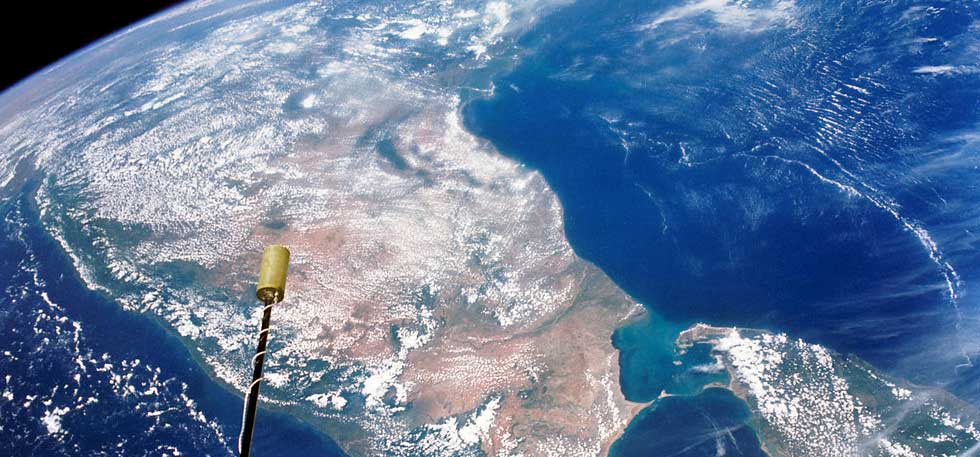Introduction
South Asia is a growing economy in the global arena, and the eight-member states of the region have substantial geopolitical importance on the world political map. South Asia can be characterized as the most disaster-prone region in the world and a victim of global warming. The continent is also battling with poverty, hunger, numerous environmental issues, epidemic and pandemic to name a few. So, the regional countries need space technologies to reduce the threats of disasters, enhance their economic advancement and improve people’s lives in South Asia.
As we know, space has become the tool for security surveillance, economic development and achieving sustainable development goals. No states – whether they are big or small – can deny the importance of space policies.
Now let’s focus our attention as to who are the space players of South Asia? India is the only major space-faring nation in the zone, which started its space program in the 1960s. India’s space journey and achievement are unique in many cases, compared to other space-faring nations. India’s space program has set an example of a cost-effective space mission.
After India’s independence and against economic challenges, former premier Pundit Jawaharlal Nehru inspired India to explore the outer space. In the initial stage, India’s space program was civilian-centric, and the goal was to use space technology to tackle socio-economic issues. Whereas, India was among the countries that opposed USA’s ballistic missiles program and deploying Anti-Satellite Weapon (ASAT) in orbit and emphasized that the outer space must be used for peaceful means. India’s outer space policy started changing after the 1990s.
‘China’s successful ASAT test intensified security concerns. It brought changes in India’s space strategy, and these changes called a competitive chain reaction to geopolitical rivalry on earth. It’s referred to as ‘the strategic competition among the US-China-India in the orbit as a result of geostrategic competition on earth’ (wrote Rajagopalan in 2019). India’s aspiration for space power has been reflected through its Moon and Mars mission. India’s approach today is to use space power to leverage geopolitical interests and national security. After the USSR, USA, China and India followed suit and took the ASAT test in 2019 (Elvevold, 2019).
The second space actor in South Asia is Pakistan. It started its space program in the 1960s at the same period India did. But today, Pakistan is lagging way behind India. China plays a crucial role in building Pakistan’s space program. Pakistan’s aspirations to conduct its first space mission by 2022, couldn’t see the light. Thus, Pakistan’s space agency, the Space and Upper Atmosphere Research Commission (SUPARCO), signed a Memorandum of Understanding (MOU) with a Chinese entity in 2018. With the help of China, Pakistan launched its first satellite, named ‘Pakistani Remote Sensing Satellite’ and the Pakistan Technology Evaluation Satellite in July 2018 (Khan and Ahsan, 2019). China officially confirmed that it would assist in building the Pakistan Space Centre (PSC). The Pakistan Space Centre has a vision of assembling home-grown satellites. China helped Pakistan to launch two satellites, PRSS-1 and PakTES-1A, into orbit.
The third country from South Asia in Space is Sri Lanka. South Asia n island nation has a significant participation in studying stars and galaxies, which has given Sri Lanka a different status in outer space research. Sri Lankan astronomers have sighted two new exoplanets or planets outside the solar system. Young dynamic Sri Lankan astronaut Mahesh Herath led the Kepler/K2 mission in 2019. In the same year, 2019, Sri Lanka launched its first satellite, Ravana-1, which has designed and developed by native scientists Tharindu Dayaratne and Dulani Chamika (Srinivasan, 2019).
Sri Lanka is going through many internal crisis, such as political instability and economic challenges, which have slowed down its space research program.
Bangladesh, the fourth country in the region, joined the space club in 2019. It launched its first communication satellite, the Bangabandhu-1, in 2018. The country spent approximately US$250 million to get the satellite from a French company Thales Alenia Space. The satellite launching program was assisted by USA’s private company Space X. The Bangabandhu -1 satellite is part of PM Sheikh Hasina’s vision for Digital Bangladesh by 2021 (The Hindu, 2018). Bangladesh hopes to get its second satellite Bangabandhu-2, by 2023, but the Ukraine-Russia war brought uncertainty in receiving the satellite on time.
Nepal launched its first Nano-satellite, Nepalisat-1, in 2019, and the USA supported this mission. Nepalisat-1 has designed by Nepali scientists Abhas Maskey and Harram Shrestha. The satellite launch has been endorsed by the United Nations BIRDS program in association with Japanese institutions and the Nepal academy of science and Technology (NAST). Former Prime Minister K.P Oli tweeted, ‘Though a humble beginning with the launching of NepaliSat-1, Nepal has entered the Space-Era'(Budhathoki, 2019). However, Nepal signed an agreement with France’s space company ‘Thales Alenia Space’ in 2019, hoping to launch C and Ku band commercial satellites by 2022. Nepal believes this satellite mission will be a game-changer for the country. Like other South Asia n countries, Nepal’s aim of space exploration is not for military purposes, and its focus areas are telecommunications, tourism, digital broadcasting, disaster management, etc. (Budhathoki, 2019).
Bhutan is also not far behind. With the understanding of the need for space technology, the Bhutan government signed an agreement with India’s space agency (ISRO) in 2021. The ISRO will assist Bhutan in developing a small satellite. The Bhutanese space program is the vision of the King of Bhutan, HM Jigme Khesar Namgyel Wangchuck. The Himalayan Kingdom of South Asia launched BHUTAN-1 on June 29, 2018 from Cape Canaveral Air Force Station in Florida, USA.
The Maldives is an archipelago in South Asia and its economy is mainly dependent on the ocean, and also at the same time, global warming and rising seas are security concerns for the Maldives. The Maldives initiated the space program in 2020 in collaboration with the Institute for Global Success (IGS) and the KSF space foundation. Space technology and service are essential for that small island nation to minimise the loss caused by natural calamities. Rising of ocean waters is a natural security concern for the Maldivian archipelago. The country wants to use the satellite aid to reduce the threat caused by climate change and global warming.
‘Afghanistan purchased the Afghansat-1 satellite in 2014 from the ISRO-EADS Astrium alliance. Eutelsat W2 M launched Afgan-1 in 2008 after a 15-year mission. This satellite was developed and assembled by ISRO for satellite operator Eutelsat. Afghansat-1 is expected to remain in orbit until 2020 (Lele, 2017). This satellite has provided communication support, including mobile telephony, access to ICT, and broadcast services to various areas of Afghanistan. Of the country. The Afghansat-1 satellite provides significant communication support to the periphery areas of the country.
Why small South Asian countries need space technology?
The Ukraine-Russia war ignites the fear of a third world war and has given birth to a new cold war. The Russian invasion of Ukraine challenged the existing global governance and protection of the territorial sovereignty of the smaller nations. And the war does not remain limited to land; it extended to outer space and the cyber domain. With this, the war in Ukraine provides a clear message to the rest of the world that no nation today can survive without the integrated space technology. The star link internet support reduces the causalities of war and helps the Ukraine army counter the Russian aggression; simultaneously, increasing space weaponization makes the small nations rethink their security status.
Analysing the possibility of Regional space cooperation
South Asia n countries are linked not only spatially, but also historically and culturally. But in terms of cooperation, the continent failed to secure all countries. There are many regional and sub-regional initiatives taking place, including the South Asia n Associations for Regional Cooperation (SAARC), the Bay of Bengal Initiative for Multi-Sectoral Technical and Economic Cooperation (BIMSTEC), and the Indian Ocean Rim Association (IORA). The region’s people have colossal expectations from SAARC and BIMSTEC, but ironically, none of this becomes fruitful in proving a nexus to the whole region. SAARC and BIMTEC have already committed to establishing cooperation in scientific innovation and technical collaboration. However, space is an emerging domain of hope and opportunity for the small nations of South Asia, and the domain cannot be explored without technological capacity and capability. India is the only space-faring nation that offered a regional satellite in 2014 to its neighbours to help with disaster management and natural calamities, and ‘Prime Minister Modi said, “Even the sky is not the limit for regional cooperation.” India’s successful satellite launch was welcomed by all South Asia n countries except Pakistan’ (Venkatasubramanian, 2017). At the launch of the Polar Satellite Launch Vehicle, Prime Minister Modi urged the Indian Space Research Organization (ISRO) to develop a satellite for SAARC member states. India’s proposal to bring the whole of South Asia under one satellite umbrella was a major part of the ‘neighbourhood first’ policy. India launched the South Asia satellite in 2017 to facilitate wide-ranging communications and meteorological support. The satellite launched into geosynchronous with a mission life of more than 12 years.
With some anxieties, Sri Lanka is the first country in South Asia, which accepts India’s regional satellite project; Bangladesh was sceptical initially, although at last, it agreed to come under one satellite. Afghanistan also welcomes India’s move. The idea of the SAARC satellite could not earn much as a regional initiative due to Indo-Pakistan disagreement regarding the project monitoring and finance issues. Lastly, India renamed the SAARC satellite as South Asia Satellite and it’s mostly a communication satellite provides support in the various area which includes_ “Internet connectivity, direct-to-home television, tele-education, tele-medicine, and disaster management, meteorological applications, fishing and agricultural advisory notices, and natural resource mapping etc.” (Set, 2017: 1-2).
Economic interest and various traditional and non-traditional security issues remain essential in the pursuit of outer space programs in South Asia n countries.
In the context of regional cooperation, the region is lagging far behind compared to Europe and Africa. Regional geopolitical rivalries, disputes, distrust, and external influence are significant barriers against space cooperation in South Asia. Unfortunately, regional bodies like SAARC have failed to enhance technological or scientific knowledge-sharing effectively. The distrust between India and Pakistan remains a major deadlock against any space collaboration and cooperation. Conversely, a country like China remains an external overbearing influencer in South Asian politics and regional order. China’s assistance to Pakistan’s space program could have a security application for India or others. Though India contains an advanced level space program, the existing geopolitical rivalries between India and Pakistan and India-China rivalries have implications for delaying integrated space cooperation in South Asia.
So, as a space power country in South Asia, India should come forward to provide space operations to other small countries of South Asia, which will accelerate the region’s economic development. South Asia is the most disaster-prone region of the world; all countries in South Asia are trying to achieve the United Nations’ Sustainable Development Goals (SDG). No countries in the continent can deny the role of space service in economic growth development.
The geopolitical complexity always creates a dilemma for small countries to seek cooperation and collaboration from major countries like India or China.
Conclusion
Hence, space is a domain where any space aspirant needs high technological knowledge, innovation, economic capability and labour. Hence, without regional space cooperation and collaboration, small nations would not able to build critical space infrastructure. The extension of regional geopolitical rivalries is causing barriers to space cooperation in South Asia. The South Asian countries are also part of Indo-pacific policy, as major Quad countries are coming together to enhance space cooperation. So it is high time for the smaller nations in South Asia to initiate the regional space policies, partnerships, and collaborations. Because space is now gradually getting crowded and congested and became more completive with the rise of private actors’ participation and considered as the new business frontier and a highly invested domain. The regional space policy framework and cooperation will help small countries in South Asia to build independent space programs.
Outer-space treaty established celestial bodies and cellular bodies as global commons, but the treaties’ ambiguity and loophole is privileged to major space players. Orbital slots are not easily accessible for smaller countries. The commercialization of space and mega-constellation in medium earth orbit and lower earth orbit is a genuine concern for South Asia. Space is facing severe threats due to space debris, which is a critical anthropogenic concern, South Asian nations should also address these issues in regional and global platforms.
Farjana Sharmin
(Farjana Sharmin is a Doctoral Candidate, Department of International Relations, Faculty of Social Sciences, South Asian University, New Delhi, India. Her research interest includes International Relations, Geopolitics, Geopolitics of Outer-Space, Space policy, Space Strategy and Security focus on South Asia. The author can be reached at https://www.linkedin.com/in/most-farjana-sharmin-south-asian-b08898121)
Reference:
Ahsan, A., & Khan, A. (2019). Pakistan’s Journey into Space. Astropolitics, 17(1), 38-50.
Banskota,R.(2021) Finally, Nepal to get own satellite, Nepali Times, Retrieved from, https://www.nepalitimes.com/latest/finally-nepal-to-get-own-satellite/
Buzan, B. (2003). Regional Security Complex Theory in the Post-Cold War World. In Theories of New Regionalism (pp. 140-159). Palgrave Macmillan, London.
Bollfrass, A. K., & Herzog, S. (2022). The War in Ukraine and Global Nuclear Order. Survival, 64(4), 7-32.
Budhathoki, A. (2019). Nepal’s Space Program Aims to Break Geopolitical Barriers, The Diplomat, Retrieved from: https://thediplomat.com/2019/04/nepals-space-program-aims-to-break-geopolitical-barriers/
Bhutan signs agreement with India’s space agency to develop satellite (2021), South Asia Monitor, Retrieved from, https://www.southasiamonitor.org/bhutan/bhutan-signs-agreement-indias-space-agency-develop-
Bhutan to Create Own Space Agency and Launch CubeSat in 2018(2018) Spacewatch Asia pacific, https://spacewatch.global/2018/02/bhutan-to-create-own-space-agency-and-launch-cubesat-in-2018/
Collins, A. (2004). State-induced security dilemma: maintaining the tragedy. Cooperation and Conflict, 39(1), 27-44.
Elvevold, E. B. (2019). War in space: why not? A neorealist analysis of International Space Politics (1957-2018) (Doctoral dissertation).
Finch, M. J. (1985). Limited Space: Allocating the geostationary orbit. Nw. J. Int’l L. & Bus., 7, 788.
Hasan, M. (2022) Bangabandhu satellite-2: War casts uncertainty over timely launch, Daily Star, Retrieved from, https://www.thedailystar.net/news/bangladesh/news/bangabandhu-satellite-2-war-casts-uncertainty-over-timely-launch-2979271
Hussain, M. Z., & Ahmed, R. Q. (2019). Space Programs of India and Pakistan: Military and Strategic Installations in Outer Space and Precarious Regional Strategic Stability. Space Policy, 47, 63-75.
Goswami, N. (2020). India’s Space Program, Ambitions, and Activities. Asia Policy, 27(2), 43-49.Stability. Space Policy, 47, 63-75.
Lele, A. (2017) India launches a South Asia satellite, The Space Review, Retrieved from, .https://thespacereview.com/article/3233/1
Kumer, H. & Gettleman, J. (2019). India Shot Down a Satellite. Modi says, Shifting Balance of Power in Asia, The New York Times, Retrieved from, https://www.nytimes.com/2019/03/27/world/asia/india-weather-satellite-missle.html
Khan, A., & Sadeh, E. (2019). Introduction: Space Power and Security Trilemma in South Asia.
Miller,N.L.(2022)Why the war in Ukraine won’t spark a nuclear proliferation cascade, Foreign policy, Retrieved from https://foreignpolicy.com/2022/10/17/ukraine-war-russia-nuclear-proliferation-iran-south-korea/
Klinger, J. M. (2020). Critical Geopolitics of Outer Space. Geopolitics, 1-5.
Reddy, R. S. (2017). Exploring space as an Instrument in India’s Foreign Policy and Diplomacy, In Rajagopalan, R. P., & Prasad, N. (Eds.). Space India 2.0: commerce, policy, security and governance perspectives. 165- 172. Observer Research Foundation.
Set, S. (2017) India’s regional diplomacy reaches Outer Space, Carnegi India, and Retrieved from, https://carnegieendowment.org/files/7-3-2017_Set_IndiaRegionalDiplomacy_Web.pdf
Srinivasan, M. (2019). Sri Lanka on an Astronomical High. The Hindu, Retrieved from, https://www.thehindu.com/news/international/sri-lanka-on-an-astronomical-high/article29244261.ece
Seldon,P. (2018) Bhutan launches its first satellite into Space, The Bhutanese, Retrieved from, https://thebhutanese.bt/bhutan-launches-its-first-satellite-into-space/
Venkatasubramanian, K. V. (2017). South Asia n Satellite to Boost Regional Communication, Press Information Bureau, Government of India, Special Service and features. Retrieved from, https://pib.gov.in/newsite/printrelease.aspx?relid=161611
Vance, A. (20 October, 2022) Elon Musk’s Starlink is at forefront of a corporate space war in Ukraine, Bloomberg, https://www.bloomberg.com/news/articles/2022-10-20/elon-musk-s-starlink-walks-new-geopolitical-turf-in-ukraine?leadSource=uverify%20wall




